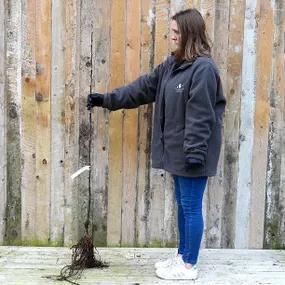Orleans Reinette Apple Trees

The details
- Height: to 4.5m
- Use: Eating/cider/cooking
- Pruning: Spur bearer
- Pollination: Self Sterile, Triploid
- Picking: mid-Oct
- Apple colour: Red
- Pollination Group: Group E
Recommended extras
Description
Malus domestica Orleans Reinette
It is such a romantic name for a super eating apple. Orleans Reinette apples are flat, looking like those wonderful doughnut peaches, and red with a little russeting. Ripening late in the season, they look as delicious as they taste: aromatic, sweet but with enough tartness to stop the taste cloying. Some compare it with a Blenheim Orange, but we think its flavour is superior. The yellowish flesh is crisp but only slightly juicy with a fine texture. The blossom is pretty and tends to last longer than on most apple trees.
The tree is a fairly light cropper, which makes it unpopular with farmers but is often ideal for the needs of the home grower - a large yield isn't much use if you can eat it all!
Browse our range of apple trees or see the full variety of fruit trees.
Orleans Reinette
Known for their flavour when fresh, they also make a great baking apple because they do not collapse when cooked and it retains its very special taste. On top of that, it can also be used to make cider. Unusually for a late apple, it does not store particularly well, only for about three weeks.
As a triploid tree it does need a pollinating partner to ensure that it crops as well as it can. Any group E or D apple will do but a good combination might be to have an eater like Ellisons Orange which crops in September and a cooker like Bramley which cooks to a fluffy purée. Finally, make use of that extended flowering period! Plant Orleans Reinette somewhere visible from the house so you can marvel at all that blossom.
Features
- Height: Bush to 3 m. Trees to 4.5m
- Use: Eating/cooking/cider
- Pruning: Spur bearer
- Pollination: Self-sterile triploid (cannot pollinate other trees)
- Picking: mid-Oct
- Apple colour: Red over yellow skin
- Pollination Group: Group E
- Storage: 1-2 weeks
Planting Instructions
Clear and weed a circle at least 1m in diameter (and keep it weeded after planting).
Make a square hole that is comfortably wider than the roots but only 5 cm deeper. The hole should be at least 30cms from any wall.
Bang in a tree stake off centre and to the south west if your Orleans Reinette is free standing.
Soak the roots in water for at least an hour.
Mound a little soil in the bottom of the hole and settle the tree roots on it until the soil mark on the trunk is at the same level as the surrounding soil and/or the grafting scion is at least 5cms above soil level. Remove the tree, sprinkle Rootgrow in the hole, wet the roots again to ensure good contact with the Rootgrow and return to the hole.
Backfill slowly, treading down gently as you go. Use a tree tie to attach your tree to the stake if freestanding.
Fit a treeguard. Water in with about 2 gallons/9 litres of water. Mulch the whole area. Water again the next day and then weekly afterwards through the first summer.
Did You Know?
Nothing could be more true for this particular apple which started out in France and was first recorded in 1776. One hundred and fifty years later it re-appears as Winter Ribston to be awarded its RHS AGM in 1917 and then returned to Orleans Reinette in 1921. It has squillions of aliases from Zimnii Shafran to Madam Calpin via Doerell's Rosmarin-Reinette and Crackling Pippin. Such a string of identities is testimony to its popularity in many countries and cultures.

 Img 1.webp)
 Img 1.webp)
